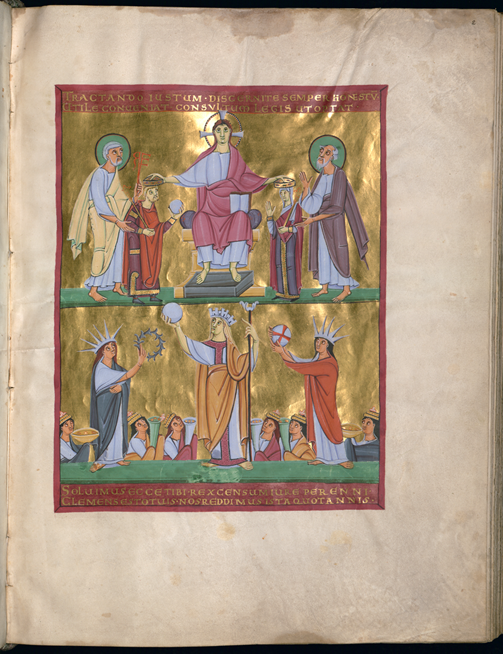Lauren Van Nest // Sacral Performance & Extended Royal Bodies in the Ottonian Empire: The Case of Henry II & Kunigunde (1002–1024)
Preciousness was used as a rhetorical tool to make the cultural concepts of power and divinity concrete in medieval Europe. The language used to describe the aesthetics of gems, gold, and precious metals—their sheen, gleam, clarity—was applied in word and image to medieval rulers to make permanent and visible to their constituents their virtues, inheritance, and ultimately claim to the throne. While objects of royal regalia—the crowns, orbs, robes, and scepters—have been discussed as reflections of the rulers' legitimacy, my research takes the materiality of these objects as a springboard to examine what the preciousness of these objects tells us about the formation of power and identity. The dissertation investigates how materiality operates in the portraiture of Holy Roman Emperor Henry II and Empress Kunigunde (r. 1002-1024) to make preciousness intrinsic to their personhood, gendered identities, and constitutive of their divinity. They were the last rulers of the Ottonian Empire, spread over central Europe in the tenth and early eleventh centuries.
 The dissertation situates three portraits of Henry II, Kunigunde, and Christ—two manuscript paintings donated to Bamberg in 1012 and one antependium donated to Basel in 1019—in their early-eleventh century contexts of use in order to elucidate how cultural notions of preciousness were activated in ritual and circulated through iconography shared across medium. This study attends to how artistic materials associated with divine revelation were integrated into royal iconography to articulate how the royal body accrued status, symbolism, and thus, power from the rite of coronation. In doing so, the dissertation contributes to ongoing discourse on the agency and cultural signification of artistic materials, demonstrating how the aesthetics of gems, silk, and precious metals operated in an iconography of power.
The dissertation situates three portraits of Henry II, Kunigunde, and Christ—two manuscript paintings donated to Bamberg in 1012 and one antependium donated to Basel in 1019—in their early-eleventh century contexts of use in order to elucidate how cultural notions of preciousness were activated in ritual and circulated through iconography shared across medium. This study attends to how artistic materials associated with divine revelation were integrated into royal iconography to articulate how the royal body accrued status, symbolism, and thus, power from the rite of coronation. In doing so, the dissertation contributes to ongoing discourse on the agency and cultural signification of artistic materials, demonstrating how the aesthetics of gems, silk, and precious metals operated in an iconography of power.
[Caption: Coronation of Henry II and Kunigunde, Pericopes of Henry II, 1007-1012, f. 2r, Clm 4452, Bayerische Staatsbibliothek, Munich (Image Attribution: Bayerische Staatsbibliothek, Creative Commons Attribution-NonCommercial-ShareAlike 4.0 International)]
